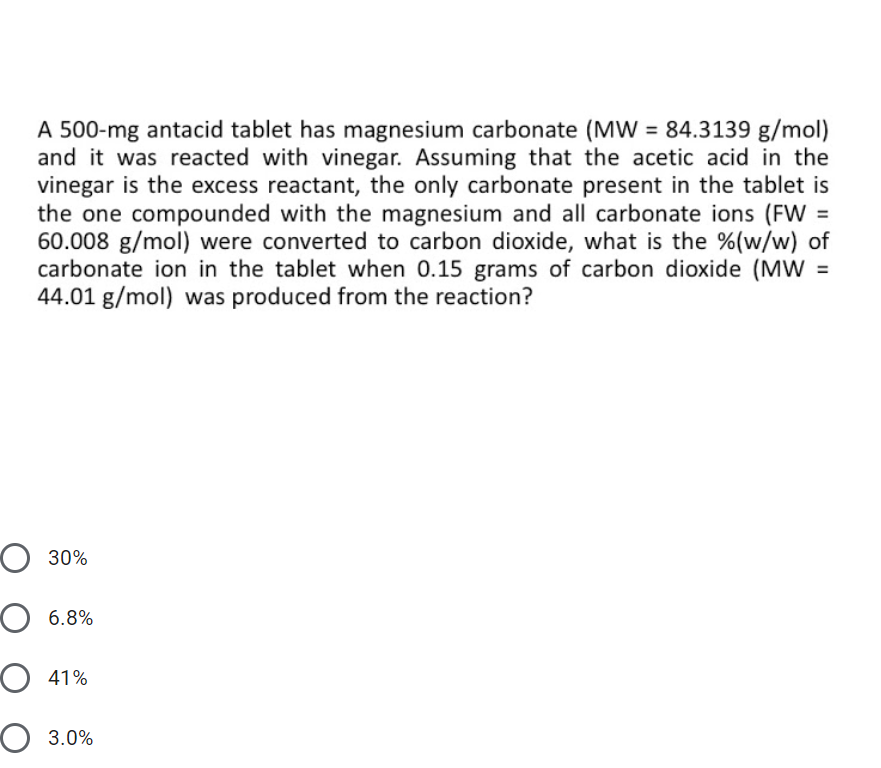A 500-mg antacid tablet has magnesium carbonate (MW = 84.3139 g/mol) and it was reacted with vinegar. Assuming that the acetic acid in the vinegar is the excess reactant, the only carbonate present in the tablet is the one compounded with the magnesium and all carbonate ions (FW = 60.008 g/mol) were converted to carbon dioxide, what is the %(w/w) of carbonate ion in the tablet when 0.15 grams of carbon dioxide (MW = 44.01 g/mol) was produced from the reaction?
A 500-mg antacid tablet has magnesium carbonate (MW = 84.3139 g/mol) and it was reacted with vinegar. Assuming that the acetic acid in the vinegar is the excess reactant, the only carbonate present in the tablet is the one compounded with the magnesium and all carbonate ions (FW = 60.008 g/mol) were converted to carbon dioxide, what is the %(w/w) of carbonate ion in the tablet when 0.15 grams of carbon dioxide (MW = 44.01 g/mol) was produced from the reaction?
Introductory Chemistry: A Foundation
9th Edition
ISBN:9781337399425
Author:Steven S. Zumdahl, Donald J. DeCoste
Publisher:Steven S. Zumdahl, Donald J. DeCoste
Chapter6: Chemical Reactions: An Introduction
Section: Chapter Questions
Problem 20QAP: Many over-the-counter antacid tablets are now formulated using calcium carbonate as the active...
Related questions
Question
Show complete solution and calculation.

Transcribed Image Text:A 500-mg antacid tablet has magnesium carbonate (MW = 84.3139 g/mol)
and it was reacted with vinegar. Assuming that the acetic acid in the
vinegar is the excess reactant, the only carbonate present in the tablet is
the one compounded with the magnesium and all carbonate ions (FW =
60.008 g/mol) were converted to carbon dioxide, what is the %(w/w) of
carbonate ion in the tablet when 0.15 grams of carbon dioxide (MW =
44.01 g/mol) was produced from the reaction?
30%
O 6.8%
O 41%
O 3.0%
Expert Solution
This question has been solved!
Explore an expertly crafted, step-by-step solution for a thorough understanding of key concepts.
This is a popular solution!
Trending now
This is a popular solution!
Step by step
Solved in 3 steps with 1 images

Knowledge Booster
Learn more about
Need a deep-dive on the concept behind this application? Look no further. Learn more about this topic, chemistry and related others by exploring similar questions and additional content below.Recommended textbooks for you

Introductory Chemistry: A Foundation
Chemistry
ISBN:
9781337399425
Author:
Steven S. Zumdahl, Donald J. DeCoste
Publisher:
Cengage Learning

Principles of Modern Chemistry
Chemistry
ISBN:
9781305079113
Author:
David W. Oxtoby, H. Pat Gillis, Laurie J. Butler
Publisher:
Cengage Learning

Chemistry
Chemistry
ISBN:
9781305957404
Author:
Steven S. Zumdahl, Susan A. Zumdahl, Donald J. DeCoste
Publisher:
Cengage Learning

Introductory Chemistry: A Foundation
Chemistry
ISBN:
9781337399425
Author:
Steven S. Zumdahl, Donald J. DeCoste
Publisher:
Cengage Learning

Principles of Modern Chemistry
Chemistry
ISBN:
9781305079113
Author:
David W. Oxtoby, H. Pat Gillis, Laurie J. Butler
Publisher:
Cengage Learning

Chemistry
Chemistry
ISBN:
9781305957404
Author:
Steven S. Zumdahl, Susan A. Zumdahl, Donald J. DeCoste
Publisher:
Cengage Learning

Chemistry for Engineering Students
Chemistry
ISBN:
9781337398909
Author:
Lawrence S. Brown, Tom Holme
Publisher:
Cengage Learning

Chemistry: Principles and Reactions
Chemistry
ISBN:
9781305079373
Author:
William L. Masterton, Cecile N. Hurley
Publisher:
Cengage Learning

Chemistry: An Atoms First Approach
Chemistry
ISBN:
9781305079243
Author:
Steven S. Zumdahl, Susan A. Zumdahl
Publisher:
Cengage Learning